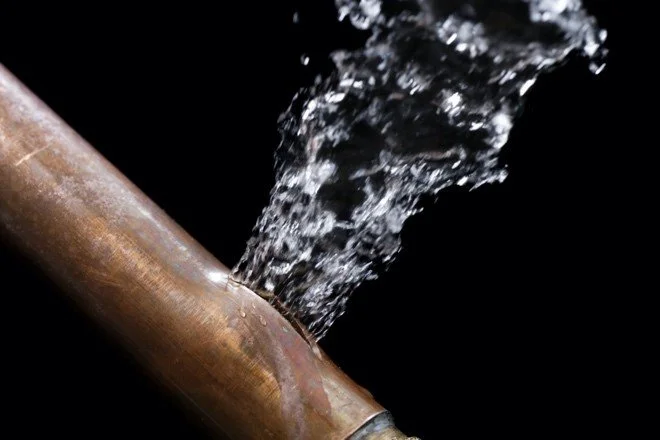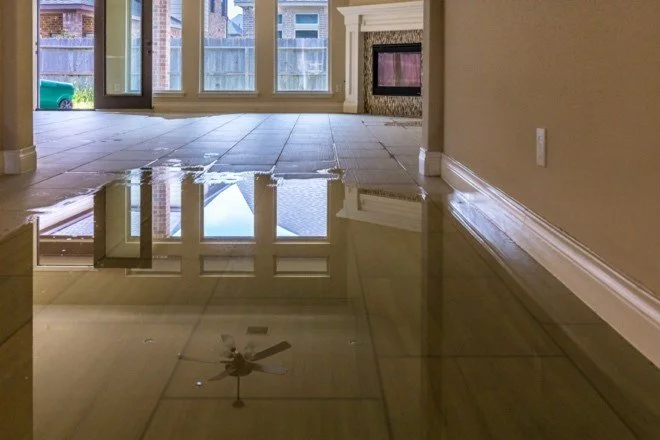Water damage to your home can be overwhelming. Whether the water leak is a burst pipe that quickly floods your basement or a faucet or toilet that has been leaking for a while and you just discovered it. This is stressful, and it’s hard to know what to do first. Most of the time, you start by shutting off the main water supply. Sometimes you grab a bucket to contain the water leak and shut off the water source to whatever is leaking.
After the initial shock and resulting stress, you immediately go into damage control. It’s hard to know what to do first or where to start. Well, for me, having years of experience in process engineering and project management before becoming a home inspector, I jump right into risk management. It’s a curse!
Let’s Start by Assessing What Type of Water Leak You Have
Low Damage – Low Cost
These types of leaks usually don’t cause damage, but instead are inconvenient, and they can cost you time, money, and energy to locate the source. There is a water leak somewhere, and you are wasting water. These costs can add up to a lot of money on your water and sewer bill. Maybe it’s a toilet that is rarely used, the sprinkler system, or perhaps the water softener. It may be hard to pinpoint, but you can hear water running in the pipes somewhere in your home.
Water Meter
Where to Start
Check and shut off all hose bibs, interior faucets, showers, and sprinkler systems.
Turn off anything and everything that has a faucet or valve and uses water. Once you have done that, if you still hear water running, you have to systematically search for the source of the water leak. This can take some time and vary in level of complexity, depending on your home.
Locate and check your water meter.
Once the previous water sources are shut down, locate and check your water meter. Water meters vary, so you may see something like an odometer. Some water meters have small dials, or icons, that will indicate low flow. Learn more about how to read a water meter here. If the indicator indicates flow, you still have a water leak somewhere in your home.
Shut down your toilets.
Water leaks from your toilets are typically the most common source of non-damaging water leaks. Turn off the water source to your toilets one by one and check the low flow indicator on your water meter. If the indicator has stopped after shutting off a particular toilet, you’ve found the culprit. If the indicator still shows a low flow, you still have a water leak.
Shut down all other water-using appliances.
One by one, shut down any other appliance or device that uses water in your home. Continue as you did with the toilets until you find your water leak. If the water leak is still undetectable, maybe it’s time to call your favorite plumber.
Moderate Damage – Moderate Cost
Moderate damage water leaks are the ones that don’t seem like a big deal, but if they go unnoticed or are ignored, they can result in significant damage over time. It could be a small water leak next to a shower stall, the drip from the dish washer or sink, or that wet spot on the basement ceiling. These may not look like a big deal on the surface, but they could be developing into a much bigger issue within your walls or ceilings.
Water leak at basement ceiling and wall
If you notice a new water leak, deal with it right away. Repeated and continuous water leaks, even if they appear to be small, typically don’t go away on their own. Ignoring them can be a big mistake.
Where to Start
Turn off the water source.
Determine if the main water valve needs to be shut off, or if you can stop the leak with another valve closer to the source.
Clean up the mess immediately.
If you catch a water leak soon enough, the mess may be minimal, but you should clean it up immediately. Failure to dry up a water leak can result in mold or mildew. Disinfect the area if possible and get a fan and/or dehumidifier going as soon as you can.
If any organic growth has started, be conscientious and take precautions to minimize spreading mold spores throughout your home. Protect yourself by wearing the appropriate protective clothing if you are to handle anything that may be dangerous. As my dad used to say, it’s better to be safe than sorry!
Resolve the leak at its source.
Determine exactly where the water leak is originating. Replace or fix whatever is leaking and make sure that any damaged or corroded components are replaced. Take the time to analyze other components that may be suspect or waiting to be your next water leak.
Split water li ne
Significant Damage – Significant Cost
Most homeowners may never have a water leak that falls into this category. These types of water leaks can be catastrophic and result in a great deal of damage to your home. As an area of your home may be flooded, these types of water leaks are pretty obvious. Frozen or burst water lines have the potential to pump a lot of water into your home in a short amount of time. Immediate attention is necessary for this type of water leak once it is discovered.
Basement water leak
Where to Start
Turn off the main water valve.
Everyone old enough to understand should know where the main water valve is located in your home. Shut it off immediately. If the water leak is before the main water valve, you will want to call a plumber or your city water utility company. You may also want to turn off any electrical circuits in the affected area to prevent electrocution.
Document the damage.
Before you do anything else, document everything by taking photos and videos of the damage. Again, turn off any electrical circuits that may pose an electrocution hazard. Thorough documentation will go a long way towards minimizing your loss when working with your insurance company.
Contact your insurance company.
As soon as reasonable, you should contact your insurance company to report the damage to your home. They need to be aware of the water issue and may be able to guide you to the appropriate actions and sources for remediation.
Get started on the cleanup, but take care not to do anything significant before the insurance company has a chance to assess the damage. Ask them for direction and make sure to wear rubber boots, gloves, and any other protective clothing and gear you need to minimize any chances of injury.
Summary
Take immediate action if you notice something is leaking in your home. Knowing the extent of a water leak and quickly mitigating the damage is an important first step.
At HomePro Inspections, our home inspectors are trained and always look for past or active water leak issues when inspecting a home. Any issues are documented and recommended for resolution by a qualified professional.
Visit our website to learn more or to schedule your home inspection in the Rochester, Owatonna, and Faribault, MN areas. You can contact us today at (507) 202-8942 or utilize our online “Schedule Now” feature to set up an appointment.





